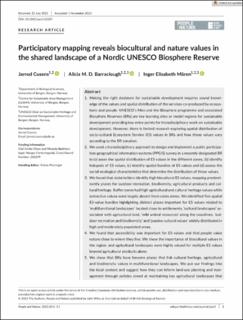| dc.contributor.author | Cusens, Jarrod | |
| dc.contributor.author | Barraclough, Alicia May Donnellan | |
| dc.contributor.author | Måren, Inger Elisabeth | |
| dc.date.accessioned | 2022-04-07T10:44:04Z | |
| dc.date.available | 2022-04-07T10:44:04Z | |
| dc.date.created | 2021-12-14T11:58:29Z | |
| dc.date.issued | 2022 | |
| dc.identifier.issn | 2575-8314 | |
| dc.identifier.uri | https://hdl.handle.net/11250/2990474 | |
| dc.description.abstract | Making the right decisions for sustainable development requires sound knowledge of the values and spatial distribution of the services co-produced by ecosystems and people. UNESCO's Man and the Biosphere programme and associated Biosphere Reserves (BRs) are key learning sites or model regions for sustainable development providing key entry points for transdisciplinary work on sustainable development. However, there is limited research exploring spatial distribution of socio-cultural Ecosystem Service (ES) values in BRs and how those values vary according to the BR zonation.
We used a transdisciplinary approach to design and implement a public participation geographical information systems (PPGIS) survey in a recently designated BR to (a) asses the spatial distribution of ES values in the different zones, (b) identify hotspots of ES values, (c) identify spatial bundles of ES values and (d) assess the social-ecological characteristics that determine the distribution of those values.
We found that stakeholders identify high biocultural ES values, mapping predominantly places for outdoor recreation, biodiversity, agricultural products and cultural heritage. Buffer zones had high agricultural and cultural heritage values while extractive values were largely absent from cores zones. We identified five spatial ES-value bundles highlighting distinct places important for ES values related to ‘multifunctional landscapes’ located close to settlements, ‘cultural landscapes’ associated with agricultural land, ‘wild animal resources’ along the coastlines, ‘outdoor recreation and biodiversity’ and ‘passive cultural values’ widely distributed in high and moderately populated areas.
We found that accessibility was important for ES values and that people value nature close to where they live. We show the importance of biocultural values in the region, and agricultural landscapes were highly valued for multiple ES values beyond agricultural products alone.
We show that BRs have become places that link cultural heritage, agricultural and biodiversity values in multifunctional landscapes. We put our findings into the local context and suggest how they can inform land-use planning and management through policies aimed at maintaining key agricultural landscapes that provide social-ecological resilience. Additionally, we discuss the value of our study for the wider BR network and how similar work can contribute to monitoring of BR implementation. | en_US |
| dc.language.iso | eng | en_US |
| dc.publisher | Wiley | |
| dc.rights | Navngivelse 4.0 Internasjonal | * |
| dc.rights.uri | http://creativecommons.org/licenses/by/4.0/deed.no | * |
| dc.title | Participatory mapping reveals biocultural and nature values in the shared landscape of a Nordic UNESCO Biosphere Reserve | en_US |
| dc.type | Journal article | en_US |
| dc.type | Peer reviewed | en_US |
| dc.description.version | publishedVersion | en_US |
| dc.rights.holder | Copyright 2021 The Author(s) | en_US |
| cristin.ispublished | true | |
| cristin.fulltext | original | |
| cristin.qualitycode | 1 | |
| dc.identifier.doi | 10.1002/pan3.10287 | |
| dc.identifier.cristin | 1968306 | |
| dc.source.journal | People and Nature | en_US |
| dc.source.pagenumber | 365-381 | en_US |
| dc.relation.project | Norges forskningsråd: 280299 | en_US |
| dc.identifier.citation | People and Nature. 2022, 4(2), 365-381. | en_US |
| dc.source.volume | 4 | en_US |
| dc.source.issue | 2 | en_US |

